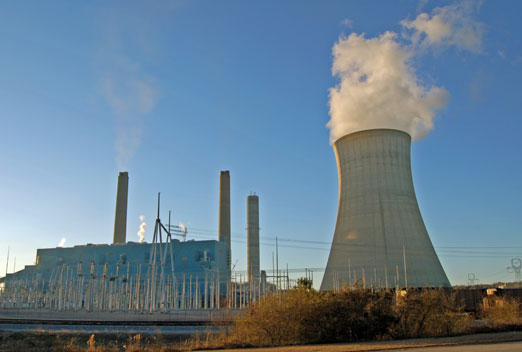
Alabama Power’s Miller Steam Plant on the Locust Fork of the Black Warrior River emits more mercury into the air than any other power plant in the country. It is also a source of fine particulate pollution and ozone, which cause the Ozone allergy or the Ozone Flu: Glynn Wilson
By Glynn Wilson –
The Environmental Protection Agency has proposed new Clean Air Act standards to cut carbon pollution from new power plants “in order to combat climate change and improve public health,” according to the announcement sent out Friday morning. The new standards are set to go into effect by June 1, 2014.
The EPA has also initiated a “abroad-based outreach” program to directly engage with state, tribal and local governments, industry, labor leaders and non-profit organizations to establish carbon pollution standards for existing power plants and build on state efforts to move toward a cleaner power sector.
The proposal is being billed as achieving the first milestone outlined in President Obama’s June 25 Memorandum to EPA on “Power Sector Carbon Pollution Standards,” a major part of the President’s Climate Action Plan.
“Climate change is one of the most significant public health challenges of our time. By taking commonsense action to limit carbon pollution from new power plants, we can slow the effects of climate change and fulfill our obligation to ensure a safe and healthy environment for our children,” EPA Administrator Gina McCarthy said. “These standards will also spark the innovation we need to build the next generation of power plants, helping grow a more sustainable clean energy economy.”
Under the proposal, new large natural gas-fired turbines would need to meet a limit of 1,000 pounds of CO2 per megawatt-hour, while new small natural gas-fired turbines would need to meet a limit of 1,100 pounds of CO2 per megawatt-hour. New coal-fired units would need to meet a limit of 1,100 pounds of CO2 per megawatt-hour, and would have the option to meet a somewhat tighter limit if they choose to average emissions over multiple years, giving those units additional operational flexibility.
These proposed standards will ensure that new power plants are built with available clean technology to limit carbon pollution, a requirement that is in line with investments in clean energy technologies that are already being made in the power industry. Additionally, these standards provide flexibility by allowing sources to phase in the use of some of these technologies, and they ensure that the power plants of the future use cleaner energy technologies — such as efficient natural gas, advanced coal technology, nuclear power, and renewable energy like wind and solar.
In response to recent information and developments in the power sector and more than 2.5 million public comments, including those from the power sector and environmental groups, the proposal sets separate standards for new gas-fired and coal-fired power plants.
Power plants are the largest concentrated source of emissions in the United States, together accounting for roughly one-third of all domestic greenhouse gas emissions, according to the best data available.
About a dozen states have already implemented or are implementing their own market-based programs to reduce carbon pollution. Mre than 25 states have set energy efficiency targets, and more than 35 have set renewable energy targets. While the United States has limits in place for arsenic, mercury and lead pollution that power plants can emit, currently, there are no national limits on the amount of carbon pollution new power plants may emit.
In 2009, EPA determined that greenhouse gas pollution threatens Americans’ health and welfare by leading to long lasting changes in climate that can have a range of negative effects on human health and the environment.
“Taking steady, responsible steps to cut carbon pollution from new and existing power plants will protect children’s health and will move us toward a cleaner, more stable environment for future generations, while supplying the reliable, affordable power needed for economic growth,” the agency says in the announcement.
The agency is seeking public comments on the proposal, and plans to hold a public hearing at some point. The EPA also pledges to take all public input into account as it completes the rulemaking process. The comment period will be open for 60 days following publication in the Federal Register on Friday.
In a separate action, the EPA is rescinding a proposal put forward in April 2012 and has initiated an outreach program to a wide variety of stakeholders that will help inform the development of emission guidelines for existing power plants.
“EPA intends to work closely with the states to ensure strategies for reducing carbon pollution from existing sources are flexible, account for regional diversity, and embrace common sense solutions, allowing the United States to continue utilizing every fuel source available,” the agency says.
President Obama’s Climate Action Plan, announced at Georgetown University on June 25, according to the agency, “takes steady, sensible, and pragmatic steps to cut the harmful carbon pollution that fuels a changing climate, prepares our communities for its impacts, while continuing to provide affordable, reliable energy for Americans.”
See more information about the proposed standards here.
See more information on President Obama’s Climate Action Plan here.
Hear an audio message on the announcement from EPA Administrator Gina McCarthy here.
Before you continue, I’d like to ask if you could support our independent journalism as we head into one of the most critical news periods of our time in 2024.
The New American Journal is deeply dedicated to uncovering the escalating threats to our democracy and holding those in power accountable. With a turbulent presidential race and the possibility of an even more extreme Trump presidency on the horizon, the need for independent, credible journalism that emphasizes the importance of the upcoming election for our nation and planet has never been greater.
However, a small group of billionaire owners control a significant portion of the information that reaches the public. We are different. We don’t have a billionaire owner or shareholders. Our journalism is created to serve the public interest, not to generate profit. Unlike much of the U.S. media, which often falls into the trap of false equivalence in the name of neutrality, we strive to highlight the lies of powerful individuals and institutions, showing how misinformation and demagoguery can harm democracy.
Our journalists provide context, investigate, and bring to light the critical stories of our time, from election integrity threats to the worsening climate crisis and complex international conflicts. As a news organization with a strong voice, we offer a unique, outsider perspective that is often missing in American media.
Thanks to our unique reader-supported model, you can access the New American journal without encountering a paywall. This is possible because of readers like you. Your support keeps us independent, free from external influences, and accessible to everyone, regardless of their ability to pay for news.
Please help if you can.
American journalists need your help more than ever as forces amass against the free press and democracy itself. We must not let the crypto-fascists and the AI bots take over.
See the latest GoFundMe campaign here or click on this image.
Don't forget to listen to the new song and video.
Just because we are not featured on cable TV news talk shows, or TikTok videos, does not mean we are not getting out there in search engines and social media sites. We consistently get over a million hits a month.
Click to Advertise Here















